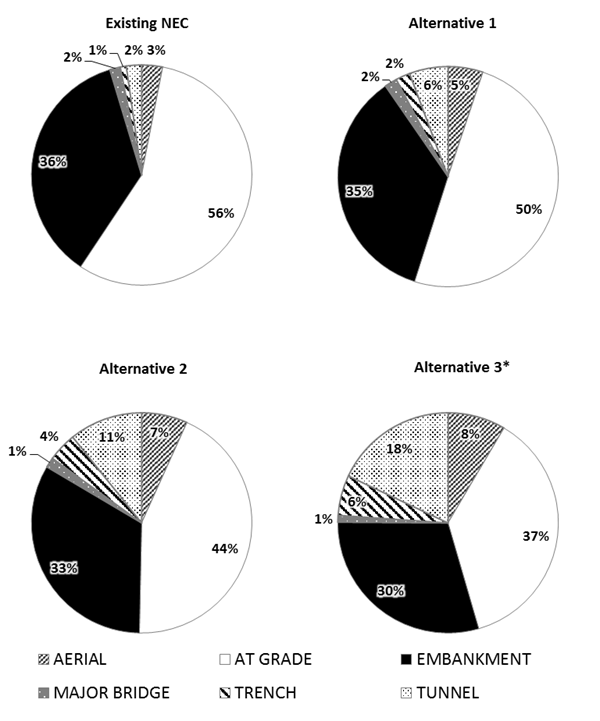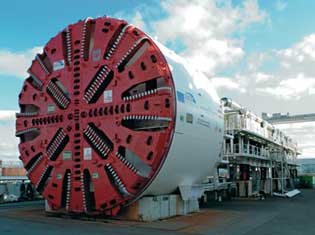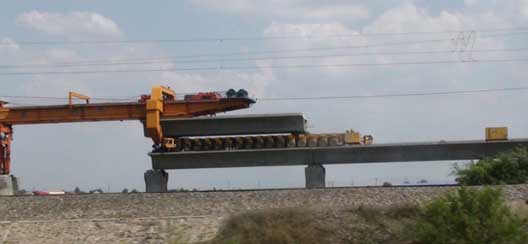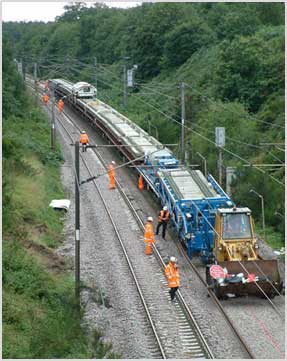
This chapter describes the potential construction types and sequencing that would likely be required for constructing any of the Tier 1 Draft Environmental Impact Statement (Tier 1 Draft EIS) Action Alternatives. This chapter also presents a qualitative description of potential construction-related effects for each of the Tier 1 Draft EIS resource areas.
The Action Alternatives would involve improvements to the existing Northeast Corridor (NEC) and construction of significant new rail infrastructure-tunnels, bridges, embankments, new stations and ancillary roads and support facilities-across the NEC over an extended period. While this chapter describes potential construction-related effects of the Action Alternatives, it is not intended to describe the precise construction methods that would ultimately be used or to dictate or confine the construction process. Actual construction staging areas, construction methods, and materials would vary, depending on how Tier 2 projects are designed to be most cost effective within the guidelines of the oversight and funding entities, and within the requirements set forth in bid, contract, and construction documents. In addition, Tier 2 environmental studies would assess and document project-specific construction activities and their impact, as well as establish project permitting requirements and mitigation measures.
Detailed project design and construction information was not available for this Tier 1 Draft EIS analysis. Therefore, the Federal Railroad Administration (FRA) developed potential construction types based on available conceptual information for each Action Alternative. Six construction types comprise the potential infrastructure associated with all of the New Track Construction (NTC) for the Action Alternatives: tunnel, trench, at-grade, embankment, aerial structure (bridges and viaducts), and major bridge. The FRA considered existing NEC construction features, as well as land use, topographic and other environmental features, and cost in developing the construction types.
This section includes a general description of the potential construction types for any of the Action Alternatives. Figure 8-1 describes the percentage of construction types by route distance for the existing NEC and each Action Alternative.
Figure 8-1 : Percentage of Route Miles by Construction Type - Washington, D.C., to Boston, MA

Source: NEC FUTURE team, 2015
* The percentage of route miles shown in Alternative 3 is the average route miles by construction type for all route options between Washington, D.C., and Boston.
The following are characterizations of each of the construction types defined for the NTC of the Action Alternatives:
Alternative 1 includes new construction within the existing NEC right-of-way to eliminate chokepoints. New construction outside the NEC right-of-way is confined to the Baltimore, MD, and New York City, metropolitan areas, and coastal Connecticut and Rhode Island. Alternative 2 includes new construction within the existing NEC right-of-way to remove speed restrictions, and provides construction of a new segment between New Haven and Hartford, CT, and Providence, RI. Alternative 3 includes construction of new segments operating between Washington, D.C., and Boston, separate from the existing NEC to create a second spine, including new route options outside the NEC right-of-way between New York City, Hartford, and Boston. Chapter 7.15, Climate Change and Adaptation, identifies known areas of the existing NEC where it is vulnerable to the effects of climate change, including increased flooding from storm events and/or rising sea levels. Where the Action Alternatives propose improvements to the existing NEC in such areas, construction of the improvements will address those underlying vulnerabilities where practical.
All of the Action Alternatives would include approximately 2.5 miles of new tunnels in Baltimore, and approximately 3 miles of new tunnels crossing the Hudson River from New Jersey to New York. In Alternative 3, tunnels would account for approximately 18 percent of the construction types, of which one route option would include approximately 22 miles of tunnel across the Long Island Sound, and another route option would include approximately 55 miles of tunnel from New York City to Hartford via Central Connecticut.
Trenches would account for approximately 2 percent and 4 percent of the construction types in Alternative 1 and Alternative 2, respectively. In Alternative 3, approximately 6 percent of the construction types would consist of trenches, which would include approximately 30 miles of trenches in Nassau and Suffolk Counties for the route option that goes from New York to Hartford via Long Island.
At-grade construction would account for approximately 50 and 44 percent of the construction types for Alternative 1 and Alternative 2, respectively. This construction would be primarily within the existing NEC right-of-way, where the existing tracks are at-grade. For Alternative 3, at-grade construction would account for approximately 37 percent of the construction types, most of which is south of New York City. North of New York City, a new right-of-way would be added between New York City, Hartford, CT, and Boston, where at-grade construction is often infeasible because of topography and development.
Embankment construction would account for approximately 35 percent and 33 percent of Alternative 1 and Alternative 2, respectively. Similar at-grade construction, this embankment construction would be primarily within the existing NEC right-of-way, where the existing tracks are on embankments. For Alternative 3, embankments would account for approximately 30 percent of the construction types, most of which would be south of New York City. North of New York City, a new right-of-way is added between New York City, Hartford, CT, and Boston, where embankment construction would not be feasible because of topography and development except prior to and following a new aerial structure.
Aerial structures would account for a small percentage of all the Action Alternatives. This would include approximately 5 miles of aerial structures between Stamford and Westport in Fairfield County, CT, for all Action Alternatives.
Major bridges would account for less than 2 percent of the construction types for all of the Action Alternatives and would include major bridges over the Susquehanna River in Maryland, and Devon, Cos Cob, and Saugatuck Rivers in Fairfield County, CT.
Implementation of dozens of infrastructure projects along an active rail corridor already operating at capacity will present severe challenges for a region that depends on reliable Intercity and Regional train service. Not only would construction of individual projects be staged to minimize disruption to ongoing train operations, but the schedule for implementing multiple simultaneous projects across the NEC would be highly coordinated and integrated to provide required construction outages and resources (both materials and workers) where and when needed. Amtrak's experience between 1994 and 2000 in rebuilding and electrifying the New Haven-Boston segment of the NEC helps to demonstrate that complex, multi-dimensional project work across a large area of an active railroad can be successfully and safely undertaken with only minor impacts to ongoing train operations. Nonetheless, the planning and staging of work to minimize adverse impacts to ongoing operations would be challenging and would require an unprecedented level of coordination among the various NEC rail operators. Even with the best of planning, likely adverse impacts could include the following:
Fortunately, while the scope of upgrades included in all of the Action Alternatives would be significant, the work required for some improvements would be undertaken sufficiently away from the existing tracks to minimize impacts to ongoing train operations. These upgrades would include a number of chokepoint projects, new bridges and tunnels, and new rail segments that would be constructed parallel to or along (or over) the existing NEC. These improvements would be designed specifically to minimize disruption to ongoing train operations.
Alternatives 2 and 3 include substantially new infrastructure built off the existing NEC. Alternative 2 includes a new greenfield2 route option between New Haven and Hartford, CT, and Providence, RI, to supplement the existing shoreline route. Alternative 3 includes construction of a new two-track second spine the entire length of the NEC. South of New York City, the new spine runs parallel to the existing NEC, with significant segments built within the existing right-of-way. North of New York City, the second spine would consist of greenfield construction off the existing NEC between New York City and Boston.
Construction in Alternative 3 off the existing NEC spine would provide some opportunity to minimize impacts on existing operations since once the new rail line is completed, some operations on the existing line would be shifted to the new route, freeing up the existing line for necessary construction activities. However, the extent of these potential benefits would be limited primarily to Intercity train service north of New York City. For example, construction of a second spine segment between Hartford, CT, and New York City (via either Central Connecticut or Long Island) prior to upgrade of the existing NEC between those cities would help to minimize impacts to Intercity train service since Intercity trains would simply relocate to the new tracks once construction is completed.
However, Regional train service between New Haven, CT, and New York City would remain on the existing NEC while that segment of the NEC is improved in order to serve existing stations. South of New York City, substantial portions of the new second spine would be located on the existing NEC right-of-way, resulting in potential disruption to both Intercity and Regional trains. Similarly, while construction off the existing NEC may reduce some costs associated with staging of construction to minimize disruption to ongoing train operations, these savings would be limited since Regional train service would continue to operate on the existing NEC during construction north of New York City, and construction within the right-of-way south of New York City would necessitate construction staging activities.
Regardless of which Action Alternative is selected, minimizing construction impacts on ongoing rail operations would be best planned and achieved by packaging projects into multiple phases of the selected alternative. Through such phases, individual projects would be timed to meet a number of important objectives. These would include optimizing the benefits across the NEC of complementary capacity and travel-time projects, balancing the demand on resources, and spacing projects to take advantage of construction outages and to minimize adverse impacts on ongoing train operations. The Service Development Plan will include a full phasing plan for the selected alternative that seeks to achieve these benefits. Chapter 10, Phasing and Implementation, includes a representative initial phase that could apply to any one of the Action Alternatives.
Most new stations would be constructed where the Action Alternative involves new right-of-way off the existing NEC. In some cases, however, new stations would be added along the existing NEC. Modifications to existing stations are proposed only on the existing NEC. New stations would be constructed concurrently with NTC. Modifications to existing stations would be completed in several phases of construction to maintain train service. These phases could involve construction of temporary run-around tracks while station platforms are expanded or modified. Once the modifications are completed, train service would be shifted back to the original track alignment.
Construction of below-ground stations would typically employ open cut-and-cover construction, depending upon the depth of construction. While TBMs are assumed for construction of tunnels, cut-and-cover construction is used for below-ground stations because of the extent of station spaces. Where the track is at-grade, on embankment or aerial structure, stations would be constructed to match the track elevation.
Figure 8-2 : Tunnel Boring Machine

Source: http://www.livesoma.com/2012/02/27/central-subway-project-update-soma-feb12/
The Action Alternatives would most likely use conventional construction techniques and equipment currently used in the Northeast and throughout the United States.
Typical equipment would include backhoe loaders, dump trucks, bulldozers, pile drivers, excavators, graders, compactors, bucket trucks, and smaller hand-operated devices such as welding equipment, rail cutters, and rail grinders. A few large-scale types of construction equipment may be required for more specialized construction associated with the Action Alternatives. For example, a TBM would likely be used for tunnel construction (Figure 8-2). This machine consists of several large pieces of machinery that bore the tunnel, remove the earth and rock debris, and support the installation of walls.
For aerial construction and major bridges, a gantry crane system (Figure 8-3) would likely be used in the field to place prefabricated sections of viaduct and track. This system has been used for aerial construction of rail tracks in both Europe and China and has also been employed to construct highway bridges in the United States. Major bridges would also likely use tower cranes to lift and position heavy materials.
Figure 8-3 : Gantry Crane System for Aerial Structure or Major Bridge Construction

Source: http://upload.wikimedia.org/wikipedia/commons/a/ab/Hada_high-speed_railway_under_const.JPG
Figure 8-4 : Typical New Track Construction Machine

Source: http://www.harscorail.com/equipment/track-construction-and-renewal/new-track-construction.html
For at-grade, embankment, and trench construction, an NTC machine (Figure 8-4) would likely be used to construct the track and the track subballast, typically crushed stone below the tracks. An NTC can install continuously welded rail and concrete railroad ties, which would be required for the NEC.
This section provides information concerning typical construction sequencing for all of the Action Alternatives. Table 8-1 outlines construction activities in sequential order and describes key tasks.
Construction of the Action Alternatives would require construction staging areas, also referred to as "laydown areas." These are areas and sites used to store materials and equipment, and to assemble construction materials. Work zones are those areas where the construction is occurring. Field offices for contractors and construction managers are usually situated in temporary job site trailers at staging areas or existing office space near the work areas.
Construction staging/laydown in urban areas, where space is limited, is often located within the street right-of-way as permitted by local transportation departments. In some instances, the laydown areas can be set within the limits of vacant urban lots or within surface parking lots. In these instances, a payment would be needed to satisfy the needs of the private property owner in lieu of utilizing public street right-of-way.
In suburban or rural areas, construction/laydown areas are typically included in the right-of-way property requirements for the project. Staging/laydown areas vary in size with construction methods and facilities being constructed, but are typically 0.5 to 1 acre in size and are adjacent to the facility construction site.
The specific location of construction staging/laydown areas would be identified in subsequent development of Tier 2 projects. Appendix A, Mapping Atlas, identifies the environmental resources within the Affected Environments for each Action Alternative. Consideration of these environmental resources would occur when identifying construction staging and access areas during subsequent project phases.
| Activity | Tasks |
|---|---|
| Pre-Construction Survey |
|
| Site Preparation |
|
| Heavy Construction |
|
| Medium Construction |
|
| Light Construction |
|
| Pre-Revenue Service |
|
Source: NEC FUTURE team, 2015
Construction effects associated with any Action Alternative would likely be short term, depending on the duration of construction activities. The areas that would be most affected by construction activities would generally comprise the area immediately bordering the construction activities. However, in some cases, effects from construction activities could extend beyond the immediate area surrounding construction sites (e.g., dust carried by wind, or noise propagated over distances).
Under the Action Alternatives, construction would include regular maintenance activities within the existing NEC right-of-way, as well as improvements that could occur outside of the existing NEC right-of-way. Project sponsors would be required to follow environmental requirements as specified in the necessary permits to minimize construction impacts.
Table 8-2 identifies examples of temporary construction effects from the Action Alternatives.
| Resource | Temporary Construction Effects |
|---|---|
| Transportation |
|
| Economic Effects |
|
| Land Cover |
|
| Agricultural Lands |
|
| Parklands |
|
| Water Resources |
|
| Ecological Resources |
|
| Hazardous Waste and Contaminated Material Sites |
|
| Cultural Resources and Historic Properties |
|
| Visual and Aesthetic Resources |
|
| Environmental Justice |
|
| Noise and Vibration |
|
| Air Quality |
|
| Energy |
|
| Safety |
|
Source: NEC FUTURE team, 2015
Construction of any Action Alternative could generate impacts to the natural and built environment. During Tier 2 EIS evaluations, project sponsors would be required to develop project-specific measures to reduce and/or mitigate construction impacts. Examples of mitigation measures that could be employed include the following:
Subsequent planning and environmental compliance processes associated with Tier 2 projects would assess temporary construction-related effects to the natural and built environment. Tier 2 analysis would be based upon site-specific design and construction methods, as well as construction scheduling and sequencing. Tier 2 evaluations would include field investigations and subsurface testing. Consultation with regulatory agencies regarding temporary construction effects and development of agreed-upon permit requirements/conditions would also be undertaken during Tier 2 evaluations.
1 Based on AREMA design criteria used on recent High-Speed Rail Studies, the desired maximum grade for high-speed track is 2.5% with 3.0% permitted in limited situations. The maximum length of continuous run at the maximum grade should be less than 10,000 feet. In order to comply with these criteria, the contours of the existing terrain may require tunneling or viaducts to meet these conditions.
2 Potential site for development-that is currently undeveloped or used as agricultural land-that lacks any existing structures.
The information posted on this website includes hypertext links or pointers to information created and maintained by other public and/or private organizations. The FRA provides these links and pointers solely for information and convenience. When users select a link to an outside website, they are leaving the NEC FUTURE website and are subject to the privacy and security policies of the owners/sponsors of the outside website. The FRA does not control or guarantee the accuracy, relevance, timeliness or completeness of information contained on a linked website, or endorse the organizations sponsoring linked websites, the views they express, or the products/services they offer. The FRA cannot authorize the use of copyrighted materials contained in linked websites and is not responsible for transmissions users receive from linked websites.